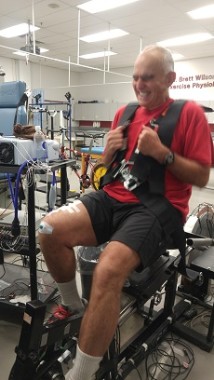EFFECTS OF SEX AND AGE ON NEUROMUSCULAR FATIGUE IN DIFFERENT INTENSITY DOMAINS
Trainee: Rafael Azevedo (PhD Student, University of Calgary)
Collaborators: Dr Juan Murias (University of Calgary)
SCIENTIFIC SUMMARY

Introduction: Neuromuscular fatigue (NMF) is influenced by the task intensity and population characteristics. Yet the time-course of NMF during acute exercise in different intensity domains is poorly understood, particularly when considering the effects of sex and aging.
Methods: Healthy young (18-40 years old) and older (65-80 years old) women and men participants will visit the lab in nine different occasions. The first four visits will include a ramp incremental test to exhaustion to evaluate maximal oxygen consumption, NMF assessments familiarization (maximal voluntary contractions and femoral nerve electrical stimulation) and 30 min constant load cycling exercise to determine the maximal lactate steady-state (MLSS). In the remaining visits, participants will cycle at constant load power output until voluntary exhaustion at: i) MLSS, ii-iii) MLSS ± 10 watts (W) and iv-v) MLSS ± 15% W. NMF assessments and blood lactate concentration will occur at baseline, every 5 min during the exercise, and at exhaustion.
Key words: sex differences, intensity domains, fatigue, cycling.
